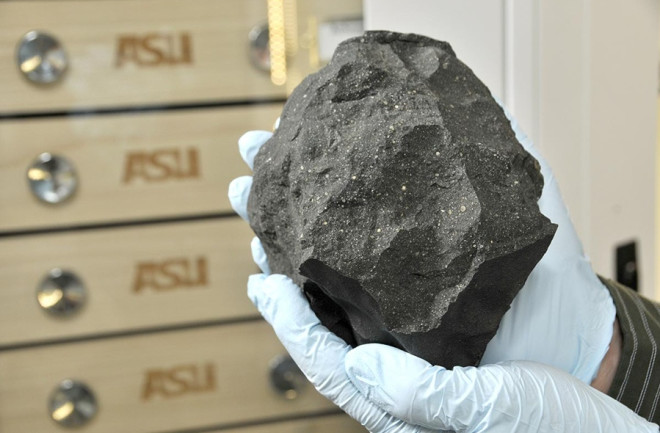Laurence Garvie can’t stop thinking about the rock that’s still out there, the one he doesn’t have, the specimen that might explain how the solar system formed or even the origin of life on Earth. That’s why, on a windy February morning in Phoenix, he escorts two men into Arizona State University’s meteorite room, a solid concrete vault lined with metal cabinets containing the collection Garvie manages: thousands of stones from the moon, Mars and the asteroid belt.
The men bear little resemblance to Garvie, a meteoriticist with a balding pate and too many pens in his pocket. In contrast, Ruben Garcia and Bob Cucchiara are fast-talking meteorite dealers dressed in blue jeans and sweatshirts. They’ve just driven 100 miles from Tucson, where they’ve been scouring the annual Gem, Mineral and Fossil Showcase for meteorites to trade with Garvie. As Cucchiara silently looks over the room, Garcia starts pulling bits of rusty metal out of his pack.
The metal fragments are a special request. “I called Laurence from the show and asked him what he wanted,” Garcia tells me as he piles them onto a digital scale. Garvie had given him names of several recent finds not yet in the ASU collection. Most of them were discovered in the deserts of northwest Africa, picked up from the sands by local tribesmen and exported to the United States by Moroccan middlemen. Garcia’s rusty specimens are no exception. They come from a meteorite called Agoudal, named after the town in Morocco’s Atlas Mountains where the fragments were recently uncovered, an estimated 40,000 years after impact. Studying the composition of nickel-iron meteorites like Agoudal is the closest scientists can come to sampling Earth’s metal core.
The deal Garcia and Cucchiara have with meteoriticist Garvie is a barter: rusty chunks of Agoudal in exchange for a few precious brown nodules from the Bondoc meteorite, an ancient 2,000-pound behemoth unearthed in the Philippines and hauled back to Arizona in the ’60s. ASU owns nearly all of Bondoc, far more than researchers will ever need. Since Bondoc is uncommon in private collections, it’s become a sort of asteroidal currency for Garvie, and also for Garcia and Cucchiara. They’ll head back to the Tucson show, where they’ll recover their outlay for the Agoudal they brought by completing a three-way exchange: A collector will get a rare Bondoc trophy piece. Garvie will acquire valuable Agoudal research material. And some Berbers in the Atlas Mountains will continue earning their living by meteorite hunting, discovering space rocks that would otherwise never be found.

